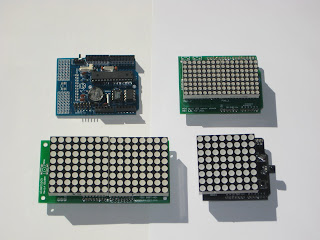This is my third and newest LED display shield for Arduino. It features two 8x8 RG (red/green/orange) 3mm LED matrices and it has the Arduino form factor, so it stacks perfectly on top of an Arduino 2009/Uno.
This Bi-color LED mini-display shield uses a similar schematic as my other Dual LED matrix shield, based on four 595 shift registers and a driver, in SMD package. The two 8x8 RG LED matrices plug into the machined (round) female headers.
The photo below shows all 3 LED shields together for size comparison, along with an Wiseduino. The "LED mini-display shield" introduced here is in the top-right corner. (All other shields in the photo are sold out.)
This LED mini-display shield also features 2 right-angle micro push buttons.
The LED mini-display shield comes fully assembled and tested.
The LED mini-display shield can be seen in this video, plugged into an Arduino running a test sketch.
The source code used in this demo can be found here.
Images of the schematic (download Eagle file) and board (download Eagle file) can be seen below.
Name that Ware, June 2025
1 day ago

















